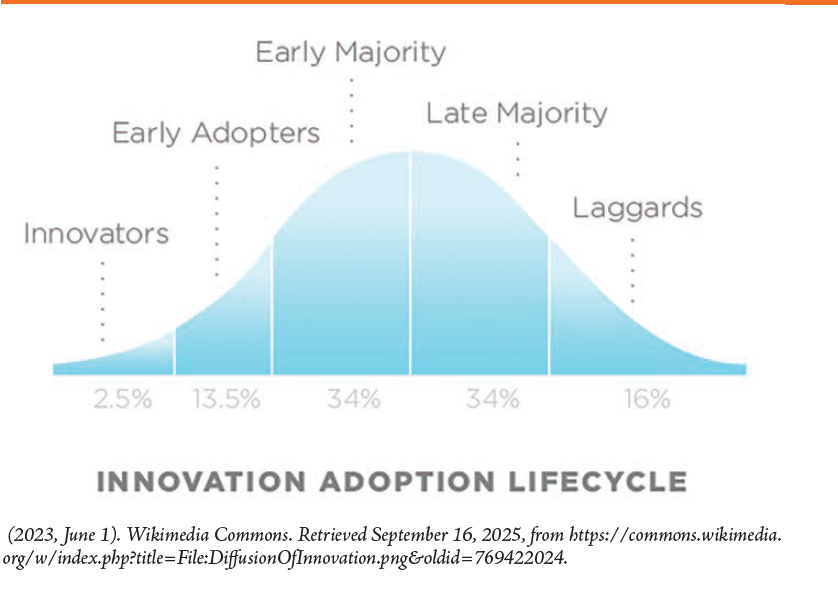By Michael Lampe, Ed.D., Manager of Learning Experience at UCHealth
From the Autumn 2025 Journal of the Colorado Dental Association
Some of you may be excited and intrigued about the numerous reports and social media posts on the abilities of artificial intelligence (AI), while others may be wary that the technology will replace many in-person jobs. I will describe two models to consider when maneuvering through AI (and any other new technology) and provide a SWOT analysis to discuss the strengths, weaknesses, opportunities and threats of the tool.
Two Cycles: Technology Adoption and Gartner’s Hype Cycle
The technology adoption lifecycle identifies users into innovators, early adopters, early majority, late majority and laggards. This process looks like a bell curve with many people hesitant to become innovators and worried about becoming laggards. During my time as program director of Digital Education and Academic Technology at CU Anschutz School of Dental Medicine, I had to balance exploring new technology with being sustainable (i.e., being financially responsible and reaching a critical mass).
Another cycle that is important to keep in mind as we are well into the AI disruption age is the Gartner Hype Cycle. This cycle has five phases: technology trigger, peak of inflated expectations, trough of disillusionment, slope of enlightenment and the plateau of productivity. Depending on your opinion on this topic, one could say we are at the peak of inflated expectations while others believe that we may be close to the slope of enlightenment. For example, many chatbot experimenters (think AI Chats) are not sufficient for everyday use, but healthcare providers may be seeing the slope of enlightenment now that they have new tools helping them improve their notetaking on which they always feel behind.
SWOT Analysis
Strengths
The most significant strength of AI in dentistry lies in its diagnostic accuracy. Tools like Pearl and Overjet analyze radiographs and CBCT scans to detect caries, bone loss, and even early signs of oral cancer with remarkable precision. This reduces missed diagnoses, supports evidence-based treatment planning and increases patient confidence. Beyond diagnostics, AI streamlines administrative tasks such as scheduling, billing, and charting, freeing up valuable chairside time and simplifying the patient’s experience at the front desk. Predictive analytics also enable dentists to forecast disease progression and simulate treatment outcomes, improving patient trust and case acceptance.
Weaknesses
Despite its promise, AI adoption faces hurdles. High upfront costs for software, hardware and staff training can deter smaller practices. There’s also a learning curve — dentists and team members must adapt workflows to incorporate AI effectively. Another limitation is data dependency; AI systems require large, high-quality datasets to function accurately. Biases in these datasets can lead to inconsistent results across diverse patient populations. This may require collaboration among industry partners or technology companies to get enough data in a smaller practice.
Opportunities
It can be difficult in a dentist’s busy day to constantly be thinking outside of the box for every patient. AI opens the door to more personalized treatment plans by limitlessly considering genetic, behavioral and lifestyle factors. In addition, teledentistry platforms powered by AI can extend care to underserved areas, while AI-driven simulations enhance patient education and case acceptance. In research and education, AI accelerates clinical studies and provides immersive training tools for dental students, shaping the next generation of practitioners. Lastly, AI can provide a higher level of patient education due to the exponential decrease in time and resources needed to create educational content.
Threats
In the U.S., dentists using AI must navigate evolving regulatory and liability landscapes. Misdiagnoses or treatment errors linked to AI could lead to malpractice claims, especially if clinicians rely solely on AI without human verification. The American Dental Association emphasizes that AI should supplement – not replace – clinical judgment. Dentists should also review their malpractice policies as standard coverage may not fully address AI-related risks. Some practices may need additional endorsements or cyber liability insurance to cover data breaches and algorithmic errors. Informed consent is another critical factor. Patients should be told when AI is part of their care plan to maintain transparency and trust.
As a society, we are still in the middle of figuring out how and when we should integrate AI so you can bounce around being an innovator or a skeptic. There is room for everyone to be part of the process so we can integrate AI into dental practices in an ethical and sustainable way.
John use the Diffusion Of Innovation photo with this story. Here is the citation for it. File:DiffusionOfInnovation.png. (2023, June 1). Wikimedia Commons. Retrieved September 16, 2025, from https://commons.wikimedia.org/w/index.php?title=File:DiffusionOfInnovation.png&oldid=769422024.

